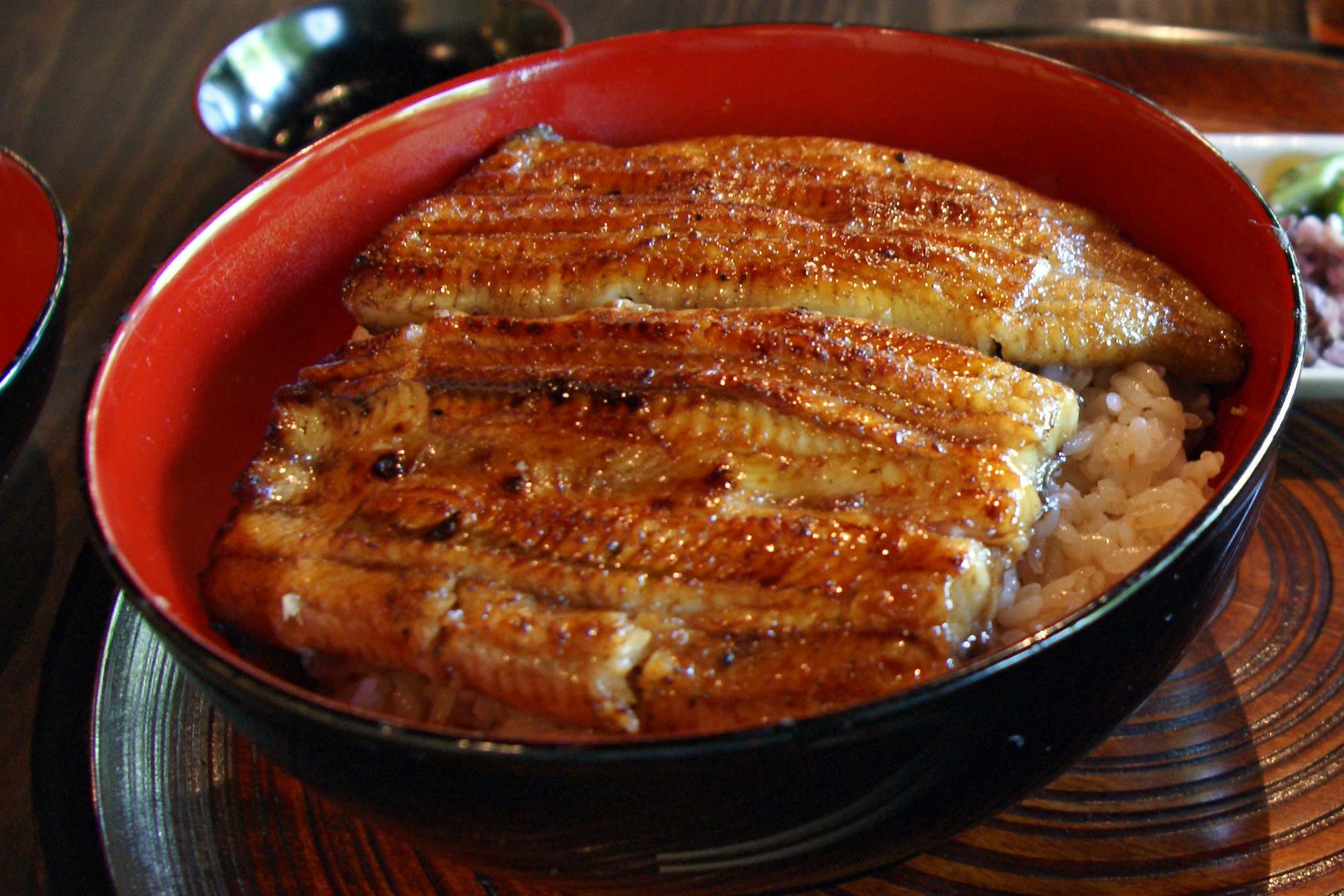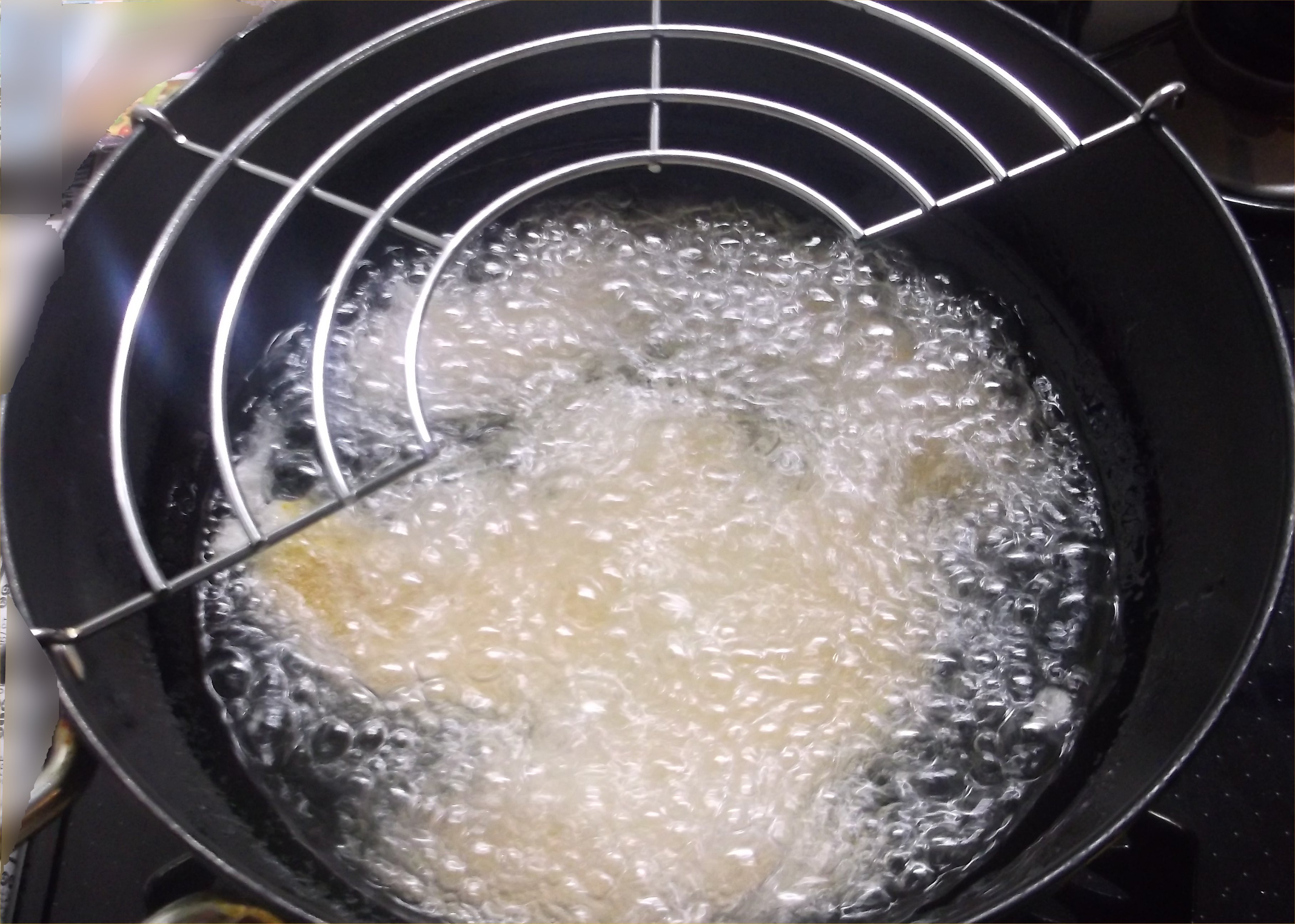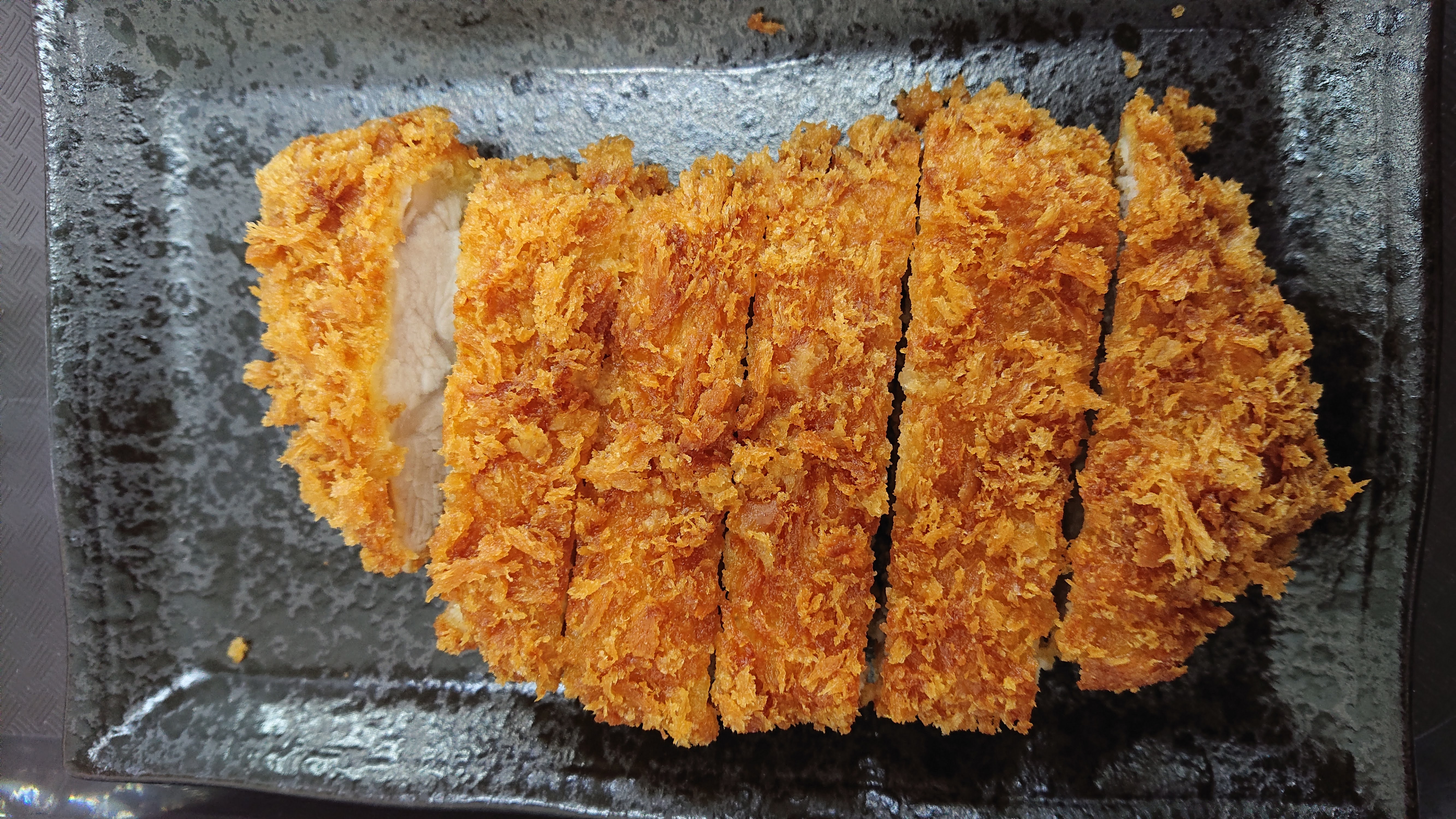|
Donburi
is a Japanese "rice-bowl dish" consisting of fish, meat, vegetables or other ingredients simmered together and served over rice. ''Donburi'' meals are usually served in oversized rice bowls which are also called ''donburi''. If one needs to distinguish, the bowl is called and the food is called . The simmering sauce varies according to season, ingredients, region, and taste. A typical sauce might consist of ''dashi'' (stock broth) flavored with soy sauce and ''mirin'' (rice wine). Proportions vary, but there is normally three to four times as much ''dashi'' as soy sauce and ''mirin''. For '' oyakodon'', Tsuji (1980) recommends dashi flavored with light soy sauce, dark soy sauce, and sugar. For ''gyūdon'', Tsuji recommends water flavored with dark soy sauce and ''mirin''. Donburi can be made from almost any ingredients, including leftovers. Varieties of donburi Traditional Japanese ''donburi'' include the following: ''Gyūdon'' , is a Japanese dish consisting of a bow ... [...More Info...] [...Related Items...] OR: [Wikipedia] [Google] [Baidu] |
Unadon (15664670489)
is a dish originating in Japan. It consists of a ''donburi'' type large bowl filled with steamed white rice, and topped with fillets of eel (''unagi'') grilled in a style known as ''kabayaki'', similar to teriyaki. The fillets are glazed with a sweetened soy-based sauce, called ''tare'' and caramelized, preferably over charcoal fire. The fillets are not flayed, and the grayish skin side is placed faced down., p.63 Sufficient ''tare'' sauce is poured over so that some of it seeps through the rice underneath. By convention, pulverized dried berries of Zanthoxylum piperitum, sanshō (called Japanese pepper, although botanically unrelated) are sprinkled on top as seasoning. It is also very popular outside of Japan, particularly in Taiwan and the Japanese Americans, United States. Variations Variations include ''unajū'' (鰻重, the same dish served in ''jūbako'' (重箱), food boxes often lacquered), ''nagayaki'' (長焼き, the eel and rice are served separately), and ''hitsumabu ... [...More Info...] [...Related Items...] OR: [Wikipedia] [Google] [Baidu] |
Oyakodon 003
, literally "parent-and-child donburi", is a ''donburi'', or Japanese rice bowl dish, in which chicken, egg, sliced scallion (or sometimes regular onions), and other ingredients are all simmered together in a kind of soup that is made with soy sauce and stock, and then served on top of a large bowl of rice. The name of the dish is a poetic reflection of both chicken and egg being used in the dish. History The origins of the dish are unknown. The earliest written mention of the terms "oyako" and "don" in combination is in a newspaper advertisement for a restaurant in Kobe in 1884. The advertisement mentions dishes named ''oyakojōdon, oyakonamidon'' and ''oyakochūdon,'' possibly referring to different sizes. Variations Several other Japanese dishes pun on the parent-and-child theme of ''oyakodon''. , literally "stranger bowl", is otherwise identical but replaces the chicken with beef or pork. A dish of salmon and salmon roe served raw over rice is known as (salmon parent-child d ... [...More Info...] [...Related Items...] OR: [Wikipedia] [Google] [Baidu] |
Katsudon 001
is a popular Japanese food, a bowl of rice topped with a fried tonkatsu pork cutlet, egg, vegetables, and condiments. The dish's name is a portmanteau of the Japanese words ''tonkatsu'' (pork cutlet) and ''donburi'' (rice bowl). Preparation The tonkatsu for the katsudon dish is prepared by dipping the cutlet in flour, followed by egg, then dipping in panko breadcrumbs, and deep-frying. Next, into a boiling broth of dashi, soy sauce and onions, the sliced tonkatsu and a beaten egg is cooked. * The PDF text misses the egg-dipping step before breading the meat. The video does demonstrate it. * videoTonkatsu & Katsudon recipe * web page linking to the video and PDFExperience Japanese Home Cooking Variants Other bowls, made of cutlet and rice but without eggs or stock, may also be called ''katsudon''. Such dishes include: * ''sōsu katsudon'' (sauce katsudon): with tonkatsu sauce or Worcestershire sauce, from regions such as Fukui, Kōfu, Gunma, Aizuwakamatsu and Komagane * ''dem ... [...More Info...] [...Related Items...] OR: [Wikipedia] [Google] [Baidu] |
Tempura
is a typical Japanese dish that usually consists of seafood and vegetables that have been coated in a thin batter and deep-fried. Tempura originated in the 16th century, when Portuguese Jesuits brought the Western-style cooking method of coating foods with flour and frying, via Nanban trade. Preparation Batter A light batter is made of iced water, eggs, and soft wheat flour (cake, pastry or all-purpose flour). Sometimes baking soda or baking powder is added to make the batter light. Using sparkling water in place of plain water has a similar effect. Tempura batter is traditionally mixed in small batches using chopsticks for only a few seconds, leaving lumps in the mixture that, along with the cold batter temperature, result in a unique fluffy and crisp tempura structure when cooked. The batter is often kept cold by adding ice or placing the bowl inside a larger bowl with ice. Overmixing the batter will activate wheat gluten, which causes the flour mixture to beco ... [...More Info...] [...Related Items...] OR: [Wikipedia] [Google] [Baidu] |
Gyūdon
, also known as , is a Cuisine of Japan, Japanese dish consisting of a bowl of rice topped with beef and onion, simmered in a mildly sweet sauce flavored with ''dashi'' (Bonito, fish and Kelp, seaweed stock), soy sauce and ''mirin'' (sweet rice wine). It may sometimes also be served with toppings such as raw or soft poached Egg as food, eggs, ''Allium fistulosum, negi'' onions, grated cheese or kimchi. A popular food in Japan, it is commonly eaten with ''beni shōga'' (pickled ginger), ''shichimi'' (ground chili pepper), and a side dish of miso soup. History After the Buddhism in Japan, arrival of Buddhism in Japan in the 6th century, consumption of meat became rare in Japanese culture (especially those of four-footed animals such as beef, cattle or pork, pigs) and in many cases frowned upon, both for religious and practical reasons. It was only after the Meiji Restoration in 1868 and the subsequent westernization of the country that meat began to be widely eaten. ''Gyūdon ... [...More Info...] [...Related Items...] OR: [Wikipedia] [Google] [Baidu] |
Pork
Pork is the culinary name for the meat of the pig (''Sus domesticus''). It is the most commonly consumed meat worldwide, with evidence of pig animal husbandry, husbandry dating back to 8000–9000 BCE. Pork is eaten both freshly cooked and preserved; Curing (food preservation), curing extends the shelf life of pork products. Ham, Gammon (meat), gammon, bacon, and sausage, pork sausage are examples of preserved pork. Charcuterie is the branch of cooking devoted to prepared meat products, many from pork. Pork is the most popular meat in the Western world, particularly in Central Europe. It is also very popular in East Asia, East and Southeast Asia (Mainland Southeast Asia, Philippines, Singapore, and East Timor). The meat is highly prized in Asian cuisines, especially in China (including Hong Kong) and Northeast India, for its fat content and texture. Some religions and cultures Religious restrictions on the consumption of pork, prohibit pork consumption, notably Islami ... [...More Info...] [...Related Items...] OR: [Wikipedia] [Google] [Baidu] |
Tonkatsu
is a Japanese dish that consists of a breaded, Deep frying, deep-fried pork cutlet. It involves coating slices of pork with Bread crumbs#Panko, panko (bread crumbs), and then frying them in oil. The two main types are fillet and loin. Tonkatsu is also the basis of other dishes such as katsu curry and ''katsudon''. Etymology The word ''tonkatsu'' is a combination of the Sino-Japanese word ''ton'' () meaning "pig", and ''katsu'' (), which is a shortened form of ''katsuretsu'' (), an old transliteration of the English word "cutlet", which was in turn adopted from the French language, French word . History Tonkatsu originated in Japan during the Meiji era in the late 19th century, a dish derived from a French cuisine, French dish known as ''côtelette de veau'', a veal cutlet coated in breadcrumbs and fried in a pan with butter. European ''katsuretsu'' (loanword/gairaigo for 'cutlet') was usually made with beef; the pork version was created in 1899 at a restaurant serving Eu ... [...More Info...] [...Related Items...] OR: [Wikipedia] [Google] [Baidu] |
Bunka
was a after '' Kyōwa'' and before ''Bunsei''. The period spanned the years from January 1804 to April 1818. The reigning emperors were and . Change of era * February 11, 1804 (): The new era name of ''Bunka'' ( meaning "Culture" or "Civilization") was created to mark the start of a new 60-year cycle of the Heavenly Stem and Earthly Branch system of the Chinese calendar which was on New Year's Day, thnew moon dayof 2 November 1804. The previous era ended and a new one commenced in '' Kyōwa'' 4. Events of the ''Bunka'' era * 1804 (''Bunka 1''): '' Daigaku-no-kami'' Hayashi Jussai (1768–1841) explained the shogunate foreign policy to Emperor Kōkaku in Kyoto. * June 1805 (''Bunka 2''): Genpaku Sugita (1733–1817) is granted an audience with Shōgun Ienari to explain differences between traditional medical knowledge and Western medical knowledge. * September 25, 1810 (''Bunka 7, 27th day of the 8th month''): Earthquake in northern Honshū (Latitude: 39.900/Longitude: 139. ... [...More Info...] [...Related Items...] OR: [Wikipedia] [Google] [Baidu] |
Beef
Beef is the culinary name for meat from cattle (''Bos taurus''). Beef can be prepared in various ways; Cut of beef, cuts are often used for steak, which can be cooked to varying degrees of doneness, while trimmings are often Ground beef, ground or minced, as found in most hamburgers. Beef contains protein, iron, and vitamin B12. Along with other kinds of red meat, high consumption is associated with an increased risk of colorectal cancer and coronary heart disease, especially when processed meat, processed. Beef has a high Environmental impact of meat production, environmental impact, being a primary driver of deforestation with the highest greenhouse gas emissions of any agricultural product. In prehistoric times, humans hunted aurochs and later domesticated them. Since that time, numerous beef cattle, breeds of cattle have been Selective breeding, bred specifically for the quality or quantity of their meat. Today, beef is the third most widely consumed meat in the world, aft ... [...More Info...] [...Related Items...] OR: [Wikipedia] [Google] [Baidu] |
Scallion
Scallions (also known as green onions and spring onions) are edible vegetables of various species in the genus ''Allium''. Scallions generally have a milder taste than most onions. Their close relatives include garlic, shallots, leeks, chives, and Allium chinense, Chinese onions. The leaves are eaten both raw and cooked. Scallions produce hollow, tubular, green leaves that grow directly from the bulb, which does not fully develop. This is different to other ''Allium'' species where bulbs fully develop, such as commercially available onions and garlic. With scallions, the leaves are what is typically chopped into various dishes and used as garnishes. Etymology and naming The names ''scallion'' and ''shallot'' derive from the Old French ''eschalotte'', by way of ''eschaloigne'', from the Latin ''Ascalōnia caepa'' or "Ascalonian onion", a namesake of the ancient Eastern Mediterranean coastal city of Ascalon. Other names used in various parts of the world include spring onion ... [...More Info...] [...Related Items...] OR: [Wikipedia] [Google] [Baidu] |
Eggs As Food
Humans and other hominids have consumed eggs for millions of years. The most widely consumed eggs are those of fowl, especially chickens. People in Southeast Asia began harvesting chicken eggs for food by 1500 BCE. Eggs of other birds, such as ducks and ostriches, are eaten regularly but much less commonly than those of chickens. People may also eat the eggs of reptiles, amphibians, and fish. Fish eggs consumed as food are known as roe or caviar. Hens and other egg-laying creatures are raised throughout the world, and mass production of chicken eggs is a global industry. In 2009, an estimated 62.1 million metric tons of eggs were produced worldwide from a total laying flock of approximately 6.4 billion hens. There are issues of regional variation in demand and expectation, as well as current debates concerning methods of mass production. In 2012, the European Union banned battery husbandry of chickens. History Bird eggs have been valuable foodstuffs since prehistory, in ... [...More Info...] [...Related Items...] OR: [Wikipedia] [Google] [Baidu] |







